Effect of Mid-Latitude Jet Stream on the Intensity of Tropical Cyclones Affecting Korea: Observational Analysis and Implication from the Numerical Model Experiments of Typhoon Chaba (2016)
Abstract
:1. Introduction
2. Data and Methods
2.1. Data
2.2. Numerical Model
3. Results and Discussion
3.1. Observational TC Intensity Changes near the Korean Peninsula and Related Environments
3.2. Numerical Experiments for Typhoon Chaba (2016)
4. Conclusions
Author Contributions
Funding
Institutional Review Board Statement
Informed Consent Statement
Data Availability Statement
Acknowledgments
Conflicts of Interest
Abbreviations
| TC | Tropical Cyclone |
| SST | Sea Surface Temperature |
| MERRA | Modern-Era Retrospective analysis for Research and Applications |
| WRF | Advanced Weather Research and Forecasting |
References
- Elsner, J.B.; Kossin, J.P.; Jagger, T.H. The increasing intensity of the strongest tropical cyclones. Nature 2008, 455, 92–95. [Google Scholar] [CrossRef] [PubMed]
- Kossin, J.P.; Emanuel, K.A.; Vecchi, G.A. The poleward migration of the location of tropical cyclone maximum intensity. Nature 2014, 509, 349–352. [Google Scholar] [CrossRef] [PubMed] [Green Version]
- Kossin, J. A global slowdown of tropical-cyclone translation speed. Nature 2018, 558, 104–107. [Google Scholar] [CrossRef]
- Wallemacq, P.; House, R. Economic Losses, Poverty & Disasters: 1998–2017; Technical Report; Centre for Research on the Epidemiology of Disasters, United Nations Office for Disaster Risk Reduction: Geneva, Switzerland, 10 October 2018. [Google Scholar]
- Mendelsohn, R.; Emanuel, K.; Chonabayashi, S.; Bakkensen, L. The impact of climate change on global tropical cyclone damage. Nat. Clim. Chang. 2012, 2, 205–209. [Google Scholar] [CrossRef]
- Lee, S.S.; Chang, E.M. Application of GIS to Typhoon Risk Assessment. J. Korea Spat. Inf. Soc. 2009, 17, 243–249. [Google Scholar]
- Park, D.S.R.; Ho, C.H.; Nam, C.C.; Kim, H.S. Evidence of reduced vulnerability to tropical cyclones in the Republic of Korea. Environ. Res. Lett. 2015, 10, 054003. [Google Scholar] [CrossRef] [Green Version]
- Park, D.S.R.; Ho, C.H.; Kim, J.H.; Kim, H.S. Strong landfall typhoons in Korea and Japan in a recent decade. J. Geophys. Res. Atmos. 2011, 116, D07105. [Google Scholar] [CrossRef] [Green Version]
- Park, D.S.R.; Ho, C.H.; Kim, J.H. Growing threat of intense tropical cyclones to East Asia over the period 1977–2010. Environ. Res. Lett. 2014, 9, 014008. [Google Scholar] [CrossRef] [Green Version]
- Zhang, S.; Nishijima, K. Statistics-based investigation on typhoon transition modeling. In Proceedings of the Seventh International Colloquium on Bluff Body Aerodynamics and Applications, Shanghai, China, 2 September 2012. [Google Scholar]
- Mudd, L.; Vickery, P.J. Advancements in Synthetic Hurricane Track Modeling in the Gulf of Mexico. In Proceedings of the 14th International Conference on Wind Engineering, Porto Alegre, Brazil, 21 June 2015. [Google Scholar]
- Nguyen, C.H.; Owen, J.S.; Franke, J.; Neves, L.C.; Hargreaves, D.M. Typhoon track simulations in the North West Pacific: Informing a new wind map for Vietnam. J. Wind. Eng. Ind. Aerodyn. 2021, 208, 104441. [Google Scholar] [CrossRef]
- Kim, J.H.; Ho, C.H.; Sui, C.H.; Park, S.K. Dipole Structure of Interannual Variations in Summertime Tropical Cyclone Activity over East Asia. J. Clim. 2005, 18, 5344–5356. [Google Scholar] [CrossRef]
- Kim, J.H.; Ho, C.H.; Lee, M.H.; Jeong, J.H.; Chen, D. Large increase in heavy rainfall associated with tropical cyclone landfalls in Korea after the late 1970s. Geophys. Res. Lett. 2006, 33, L18706. [Google Scholar] [CrossRef] [Green Version]
- Brand, S. The Effects on a Tropical Cyclone of Cooler Surface Waters Due to Upwelling and Mixing Produced by a Prior Tropical Cyclone. J. Appl. Meteorol. Climatol. 1971, 10, 865–874. [Google Scholar] [CrossRef] [Green Version]
- Gray, W.M. Global View of the origin of tropical disturbances and storms. Mon. Weather Rev. 1968, 96, 669–700. [Google Scholar] [CrossRef]
- Wong, M.L.M.; Chan, J.C.L. Tropical Cyclone Intensity in Vertical Wind Shear. J. Atmos. Sci. 2004, 61, 1859–1876. [Google Scholar] [CrossRef]
- Zheng, Y.; Alapaty, K.; Herwehe, J.A.; Del Genio, A.D.; Niyogi, D. Improving high-resolution weather forecasts using the Weather Research and Forecasting (WRF) model with an updated Kain-Fritsch scheme. Mon. Weather Rev. 2016, 144, 833–860. [Google Scholar] [CrossRef]
- Hong, S.Y.; Noh, Y.; Dudhia, J. A new vertical diffusion package with an explicit treatment of entrainment processes. Mon. Weather Rev. 2006, 134, 2318–2341. [Google Scholar] [CrossRef] [Green Version]
- Tewari, M.; Chen, F.; Wang, W.; Dudhia, J.; LeMone, M.A.; Mitchell, K.; Ek, M.; Gayno, G.; Wegiel, J.; Cuenca, R.H. Implementation and verification of the unified Noah land surface model in the WRF model. In Proceedings of the 20th Conference on Numerical Weather Prediction, Seattle, WA, USA, 10 January 2004; p. 14.2A. [Google Scholar]
- Jiménez, P.A.; Dudhia, J.; González-Rouco, J.F.; Navarro, J.; Montávez, J.P.; García-Bustamante, E. A revised scheme for the WRF surface layer formulation. Mon. Weather Rev. 2012, 140, 898–918. [Google Scholar] [CrossRef] [Green Version]
- Shafran, P.C.; Seaman, N.L.; Gayno, G.A. Evaluation of numerical predictions of boundary layer structure during the Lake Michigan ozone study. J. Appl. Meteorol. 2000, 39, 412–436. [Google Scholar] [CrossRef]
- Kwon, H.J.; Rhyu, J.Y. A New Proposition on the Definition of the Tropical Cyclone Influence on the Korean Peninsula. Atmosphere 2008, 18, 43–53. [Google Scholar]
- Holland, G.J.; Merrill, R.T. On the dynamics of tropical cyclone structural changes. Q. J. R. Meteorol. Soc. 1984, 110, 723–745. [Google Scholar] [CrossRef]
- Bosart, L.F.; Bracken, W.E.; Molinari, J.; Velden, C.S.; Black, P.G. Environmental influences on the rapid intensification of Hurricane Opal (1995) over the Gulf of Mexico. Mon. Weather Rev. 2000, 128, 322–352. [Google Scholar] [CrossRef]
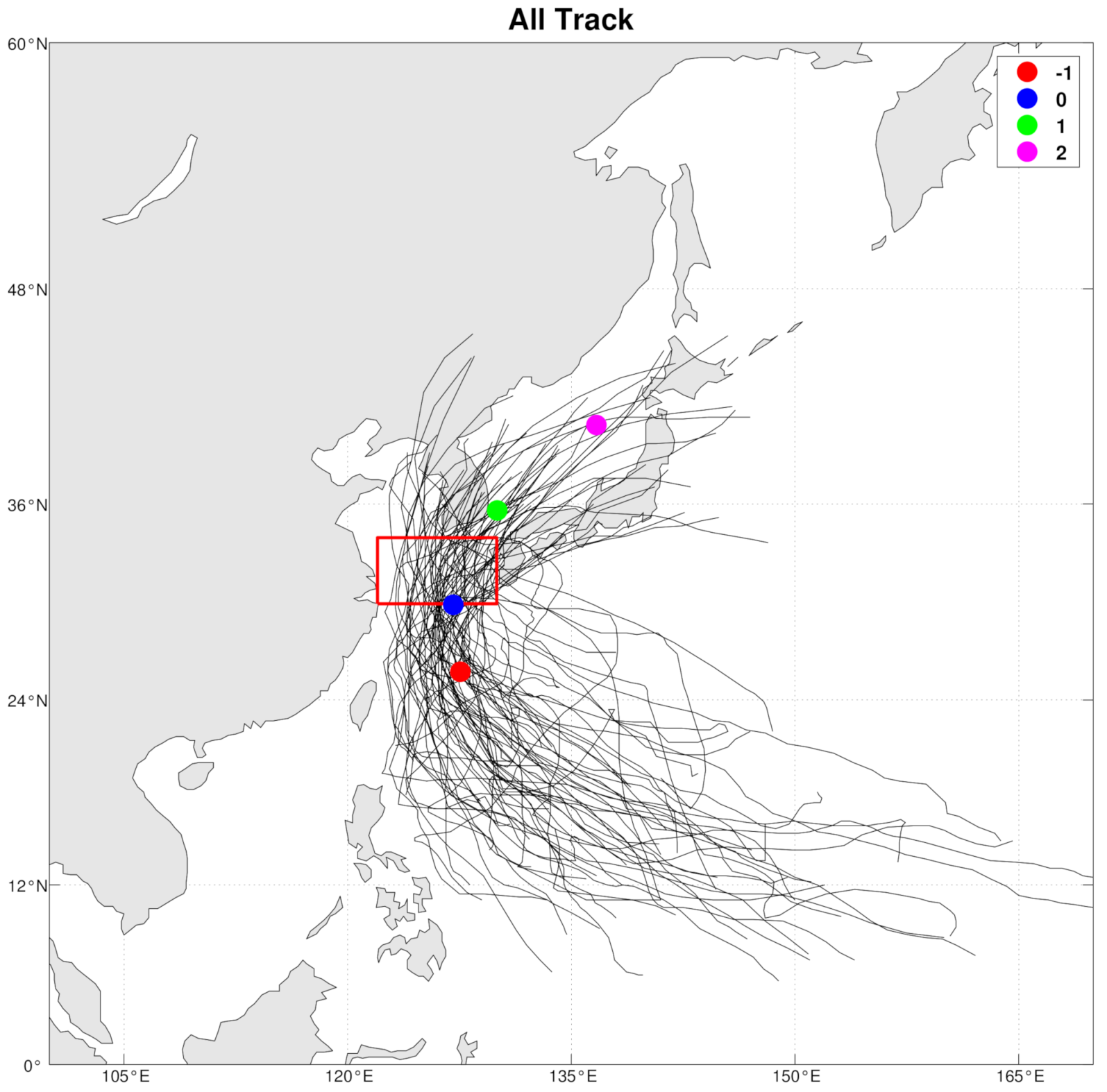

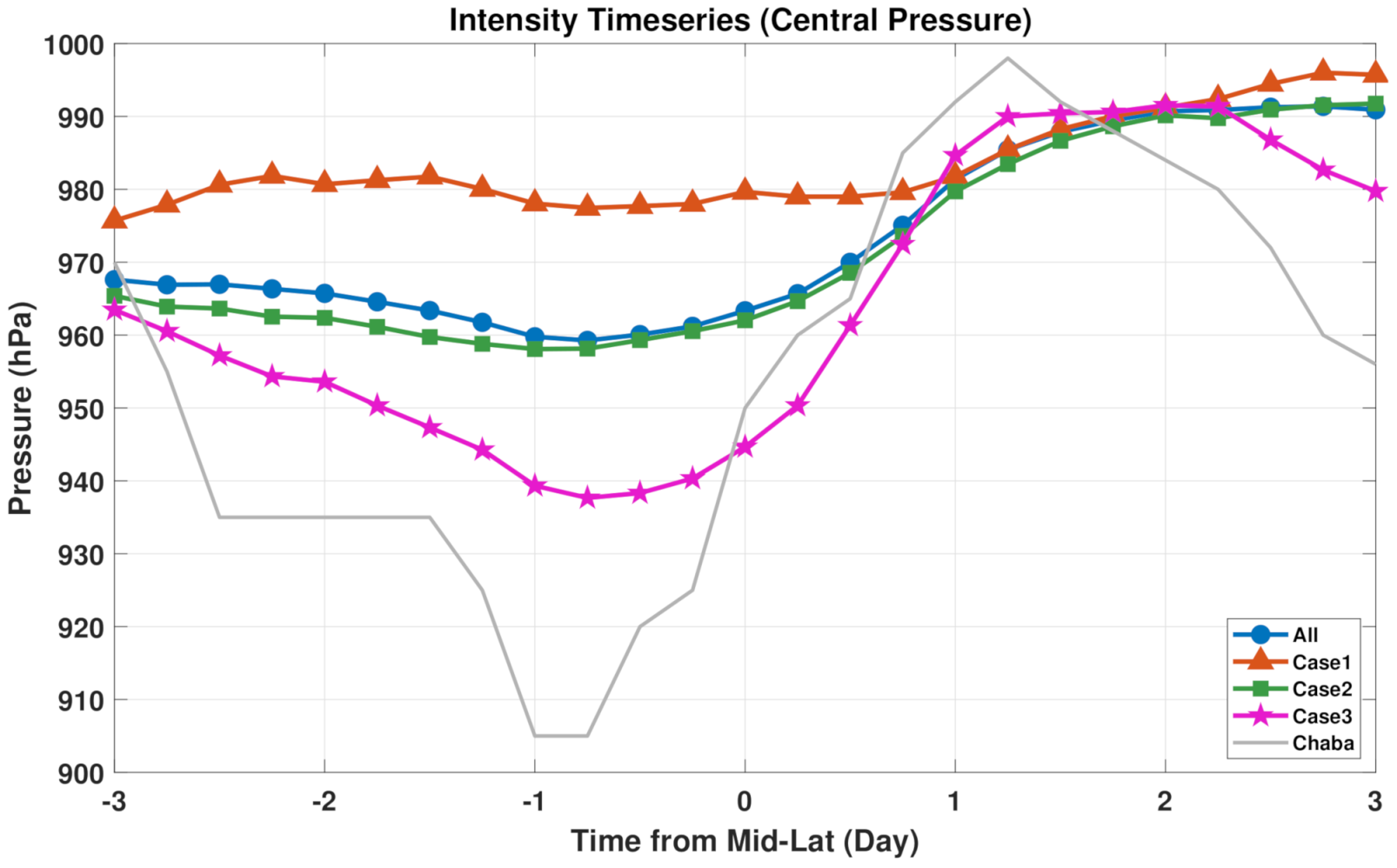

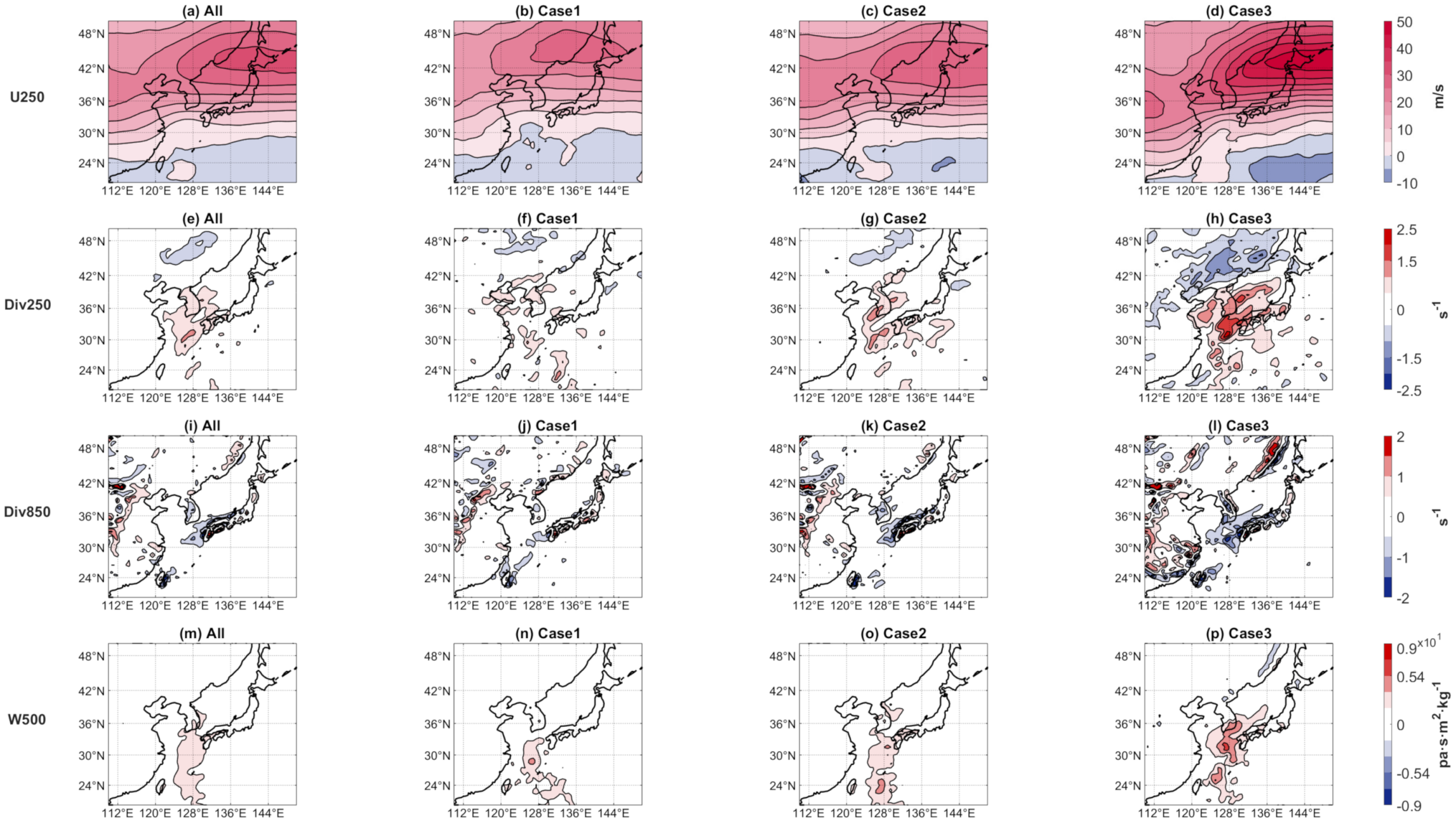
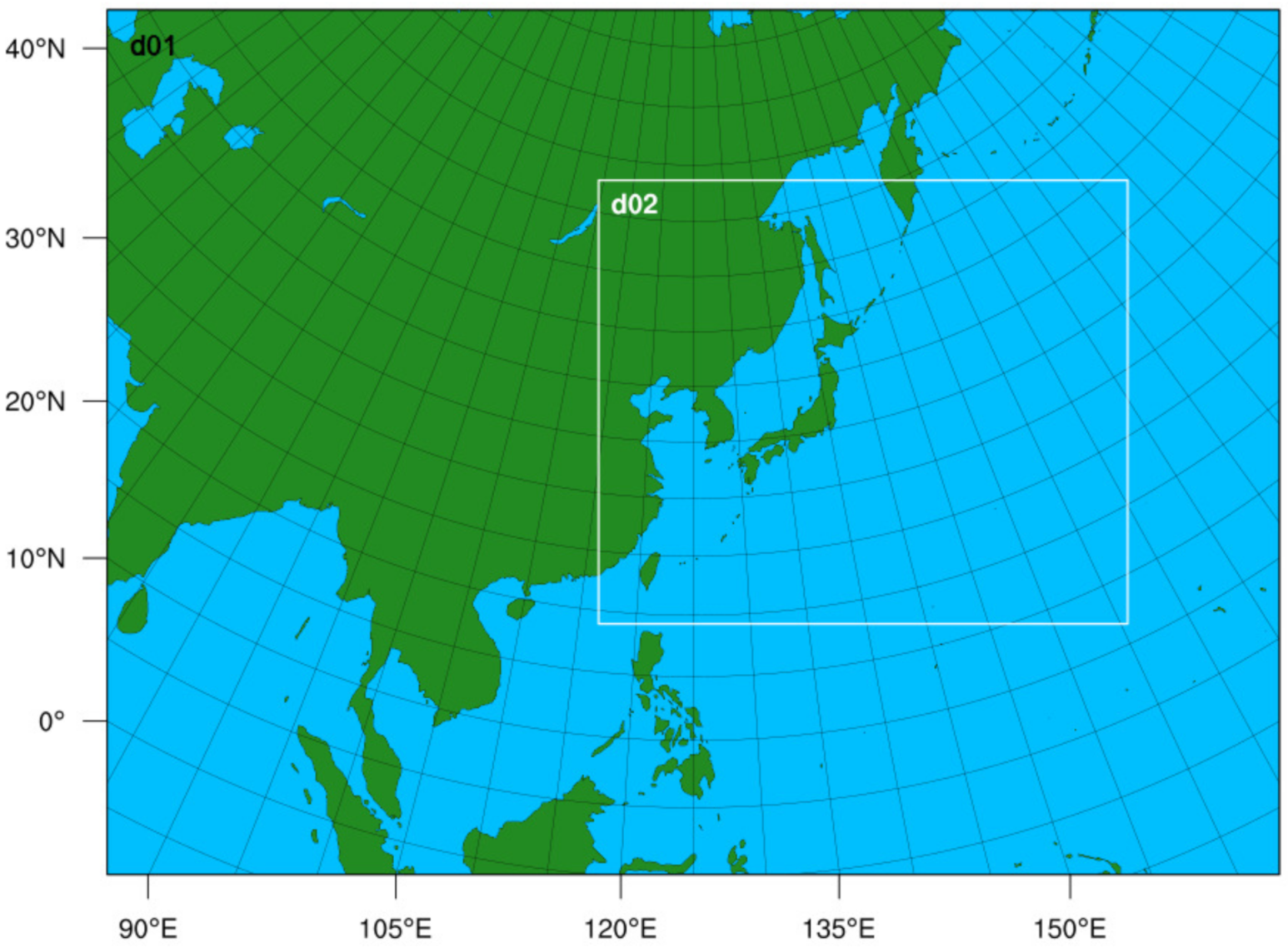

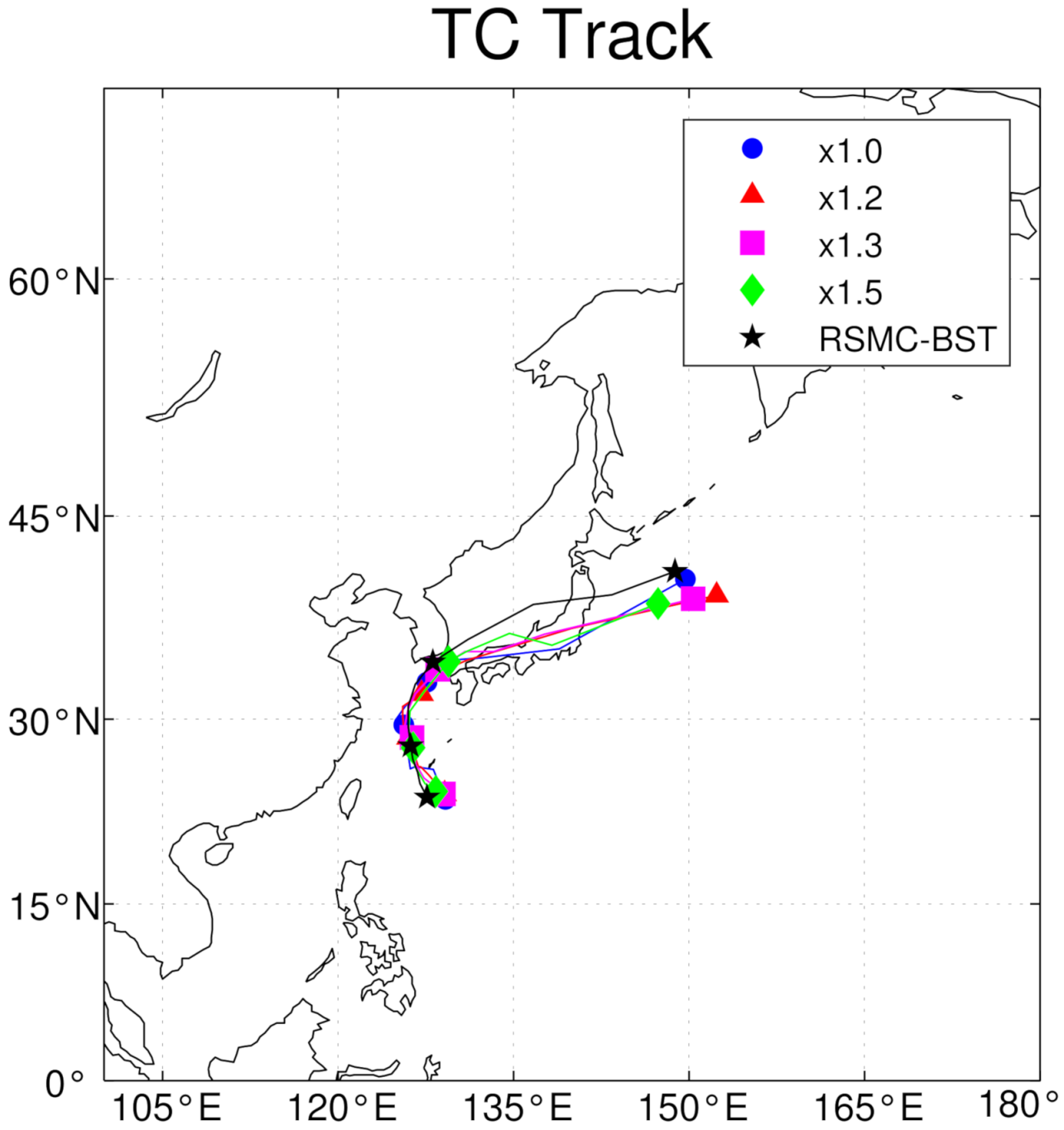


| WRF-ARW 4.1.2V | |||
|---|---|---|---|
| Integration time | 1 October 2016 00:00:00–6 October 2016 00:00:00 | ||
| Resolution of Domain 1 | 50 km | ||
| Resolution of Domain 2 | 10 km | ||
| Nested Option | Two-way Nesting | ||
| SST input Option | SST constant | ||
| FDDA option | Analysis Nudging | Surface | No |
| Spectral Nudging | Yes | ||
| Micro Physics | WRF Single–moment 6–class Scheme | ||
| PBL Physics | Yonsei University Scheme | ||
| Cumulus Physics | Multi–scale Kain–Fritsch Scheme | ||
| Radiation | RRTMG Shortwave and Longwave Schemes | ||
| Land Surface | Unified Noah Land Surface Model | ||
| Surface Layer | Revised MM5 Scheme | ||
| ×1.0 | ×1.2 | ×1.3 | ×1.5 | |||||
|---|---|---|---|---|---|---|---|---|
| r | p-Value | r | p-Value | r | p-Value | r | p-Value | |
| 850 hPa | 0.09 | 0.77 | −0.2 | 0.42 | −0.5 | 0.05 | −0.78 | <0.01 |
| 700 hPa | −0.29 | 0.26 | −0.09 | 0.77 | −0.68 | <0.01 | −0.81 | <0.01 |
Publisher’s Note: MDPI stays neutral with regard to jurisdictional claims in published maps and institutional affiliations. |
© 2021 by the authors. Licensee MDPI, Basel, Switzerland. This article is an open access article distributed under the terms and conditions of the Creative Commons Attribution (CC BY) license (https://creativecommons.org/licenses/by/4.0/).
Share and Cite
Do, G.; Kim, H.-S. Effect of Mid-Latitude Jet Stream on the Intensity of Tropical Cyclones Affecting Korea: Observational Analysis and Implication from the Numerical Model Experiments of Typhoon Chaba (2016). Atmosphere 2021, 12, 1061. https://doi.org/10.3390/atmos12081061
Do G, Kim H-S. Effect of Mid-Latitude Jet Stream on the Intensity of Tropical Cyclones Affecting Korea: Observational Analysis and Implication from the Numerical Model Experiments of Typhoon Chaba (2016). Atmosphere. 2021; 12(8):1061. https://doi.org/10.3390/atmos12081061
Chicago/Turabian StyleDo, Gunwoo, and Hyeong-Seog Kim. 2021. "Effect of Mid-Latitude Jet Stream on the Intensity of Tropical Cyclones Affecting Korea: Observational Analysis and Implication from the Numerical Model Experiments of Typhoon Chaba (2016)" Atmosphere 12, no. 8: 1061. https://doi.org/10.3390/atmos12081061
APA StyleDo, G., & Kim, H.-S. (2021). Effect of Mid-Latitude Jet Stream on the Intensity of Tropical Cyclones Affecting Korea: Observational Analysis and Implication from the Numerical Model Experiments of Typhoon Chaba (2016). Atmosphere, 12(8), 1061. https://doi.org/10.3390/atmos12081061






